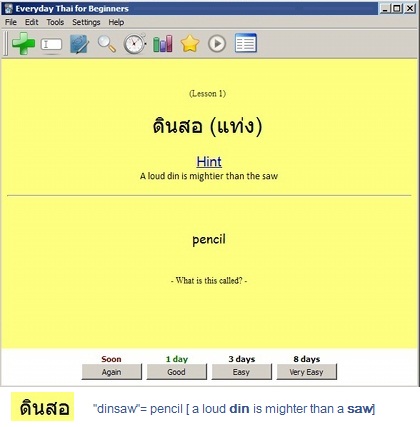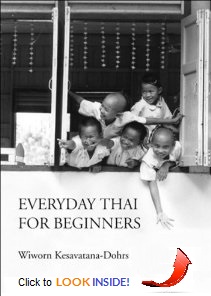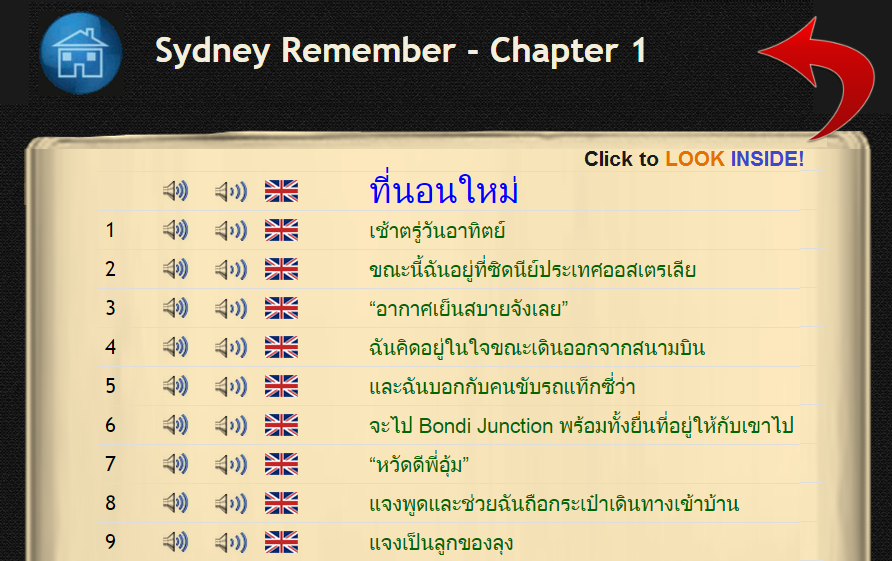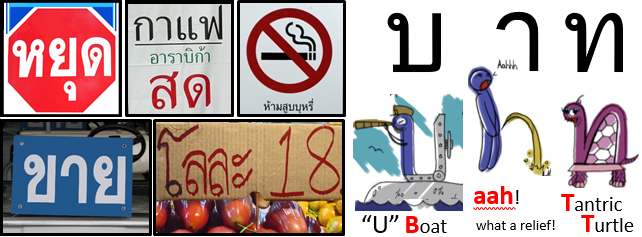Learning Path

The Rapid Method is a kind of “Yellow Brick Road”. So long as you keep on keeping on the path (no need to deviate), you will gradually become better and better at speaking and understanding Thai. It’s better to do a little every day (or every other day), regularly – even if only a few minutes during breakfast or before bedtime! – than to wait until you have the time or inclination to make a massive effort at studying several hours in one go…
I don’t want to be dishonest with the pricing like so many other sellers, pretending to provide something that seems cheap at first, but then try to sell you extra bonus products at heavily reduced prices (“only $99 reduced from $3,687!”). My pricing is what I believe my courses to be worth in terms of the benefits to you and the R&D and investment of time that I’ve put into creating the courses – no less, no more.
Besides, in the overall scheme of things, your main expense will be the roughly 100 hours for each year of private tuition. I’ve asked the independent Thai tutors to charge ฿300-฿350/hour for their time (unless there are other additional costs like travel or overtime costs). This is a fair and reasonable and inexpensive price for private tuition. I take no commission or any fee from the tutors.
The Road Map
Here is the Rapid Method’s Road Map for learning Thai (along with prices):
1. Watch the Foundation Videos on YouTube.
2. Try before you buy. Log in or sign up for the (free) trial version of the Rapid Read Thai online course and work through the first few lessons. You’ll learn around 30 of the most common letters in a few hours, after which you can recognize and correctly pronounce (but not necessarily understand) hundreds of basic Thai words.
3. Learn to Read Thai. Come back and buy the more Rapid Read Thai course (฿10,000). You can do it in a few days, but allow 1-2 months to complete this part of the process. Or if you can make it then attend one of the intensive one-week Rapid Read Thai bootcamps (฿42,000).
When you complete the course you will be able to read this!
You can extend the course by purchasing a collection of supplementary reading material consisting of menus, stories and popular (and often quite obscene) Thai songs. (This collection costs an extra ฿5,000.)
You might want to work through with the help of a Thai tutor so that you can understand the idiomatic expressions and cultural references – and to check your pronunciation as well! It’ll probably take around 30 hours to work through the material with a teacher, one story or song per week, say. (฿9,000 assuming ฿300/hour, paid directly to your tutor).
4. Learn to Speak Thai through reading. Now that you can read, follow the Everyday Thai for Beginners conversational course (฿7,000). There’s no need to rush this: two one-hour sessions per week over seven months with a private Thai tutor, either face-to-face or online via Skype… (฿18,000 assuming 60 lessons at ฿300/hour, paid directly to your tutor).
5. Become conversationally fluent. Then if you want to have deeper and more intimate conversations with your friends and (Thai) family then buy the “fluency” course, Sydney Remember (฿7,000). Allow about a year to complete this course, studying two hours per week (฿30,000 assuming 100 lessons at ฿300/hour, paid directly to your tutor).
6. Learn Business & Commercial Thai. If you also want to be able to talk about business, marketing or commercial issues then get the advanced fluency business course, Top Story (฿7,000). Allow another year, studying the usual leisurely two hours per week, to complete this course (฿30,000 assuming 100 lessons at ฿300/hour, paid directly to your tutor).
7. Advanced Thai. Finally, you might want to know what’s going on politically and economically in the country: study the News & Media course (฿7,000). Although the words used in newspapers and on the TV and radio are very advanced, there aren’t that many of them and the concepts are always the same: about the government, the opposition, the protesters, murderers, thieves and terrorists, sports stars and TV personalities, floods, fires and the weather in general, etc. It’s a completely different language from colloquial speech, but very easy to become familiar with if you put your mind to it. I’m developing an advanced course based on the book “Doggy-Style Politics” by Chuwit Kamolvisit (ชูวิทย์ กมลวิศิษฎ์), a maverick ex-gangster turned politician in Thailand (฿30,000 assuming 100 lessons at ฿300/hour, paid directly to your tutor)..
It’s a Process
The Rapid Method is a process. Less is more. I’ve devised a minimalist approach where you master a small body of essential material, rather than study mountains (and hundreds of hours) of material in the hope that some of it sticks. There’s a lot of ’muscle memory’ involved in order to make speaking and understanding an automatic skill (like driving a car or dancing or karate or playing piano).
But the must first learn to read – even if you don’t understand what you are reading.
Sure, it seems counter-intuitive, but it will really help you to speak clearly and achieve fluency relatively quickly. And you will also find that you can understand what people are saying more clearly too.
Most language schools – if they teach reading at all – focus on the wrong kind of reading, which does not help you to learn to speak Thai. This is why many people think that learning to read isn’t necessary or not particularly useful.
The primary goal of the reading course is just being able to recognize words and sound them out accurately with the correct tones.
It’s just a starting point (but an extremely important one). The two main advantages are that 1) you will be able to speak clearly and accurately in a way that Thai people can easily understand and 2) you’re able to continuously pick up Thai vocabulary and phrases from your environment without having to rely on classes or text books (which only represent Thai in an approximate and often incorrect way).
The next step is to build up a vocabulary that you can use for recognizing the meanings of sentences and for communicating verbally. The Read Thai course consists of about 500 useful words that you will memorize with an electronic flashcard system called Anki. It takes about 2-3 weeks to work through the reading course by yourself (a total of 16-18 hours) and then about a month (of about 10 minutes per day) to memorize the vocabulary with the mnemonics that I’ve included in each of the flashcards.
The Supplementary Songs and Stories comes with an extra 400-odd words consisting of the vocabulary used in the menus, songs and stories – so allow an extra month to memorize these words as well.

ดินสอ sounds like “dinsaw” = pencil
hint: a loud din is mightier than a saw… a silly play on the pen is mightier than the sword, but it works!
(The word in parenthesis is usually the classifier, as in loaf of bread.)
Then you will be ready to start on the basic conversational course(point 4. above) called Everyday Thai for Beginners. It’s based on the first-year university program at the University of Washington. This consists of 30 lessons which you work through one per week, with the help of a Thai teacher (two one-hour sessions per week). After 7-8 months, you will be able to have simple conversations in everyday situations (greeting people, asking about their family, going out to eat or watch a movie, etc., buying things, getting around by bus or taxi, dealing with money, etc.) There are about 1,100 words in this course that you will memorize as you work through the lessons.
If you then want to become conversationally fluent, you should study the romance novel Sydney Remember (point 5. above). It’s a wonderful story about a Thai girl from Bangkok going to live with her cousin in Sydney. It’s written in a plain, colloquial style with lots of everyday slang, so that you become familiar with how people speak normally to each other and can subsequently have deeper, more intimate or meaningful conversations with close friends, girlfriends (and her family), lovers, etc.
Just follow the road map above. The most effective way by far to learn to speak and understand Thai is to learn to read first. For one, you will know exactly how to pronounce a word accurately with the correct tone. The phonetic transliterations typically used in textbooks and language classes is mostly wrong and will be almost impossible to unlearn later on. Secondly, you will be able to absorb Thai continuously from your surroundings, simply by reading the street signs, notices and menus.
In the scheme of things you’ll find that your major expense will be with a private Thai tutor and I strongly recommend that you work through the courses one course at a time. Everything is built on what you’ve done previously, so it’s best just to “follow the Yellow Brick Road” and keep on keeping on.
Rapid Reading Workshops
I periodically host several reading workshops every year in Chiang Mai and Bangkok. Many people choose to work through the online course by themselves and then maybe come to a workshop to consolidate what they’ve learnt and to ‘get’ the details and nuances that they missed the first time. If you do decide to attend at a later time then it’ll just be the difference to pay between the online version of the Read Thai course that you bought and the workshop fee. If you work diligently through the course and all the supplementary material then you won’t need to attend a workshop. The workshop is primarily designed for busy/lazy people who tend to procrastinate or don’t enjoy studying alone and they want my immediate guidance and to be in a social environment where they can be more motivated to get the work done. (You will have no choice: I lock the room, rattle my whips and chains and don’t let you out until you’ve completed the course and can read Thai… LOL!)



